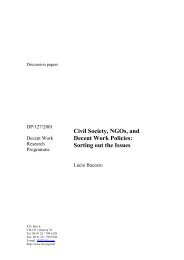The Challenges of Growing Small Businesses - International Labour ...
The Challenges of Growing Small Businesses - International Labour ...
The Challenges of Growing Small Businesses - International Labour ...
Create successful ePaper yourself
Turn your PDF publications into a flip-book with our unique Google optimized e-Paper software.
2.5 <strong>The</strong> enabling environment for women’s<br />
enterprise<br />
Figure 5:<br />
<strong>The</strong> enabling environment for women’s<br />
entrepreneurship<br />
Enterprise Support Sector<br />
(Government, NGO, Private Sector, Membership<br />
Organisations, donors etc<br />
Motivation &<br />
Determination<br />
Idea with a<br />
Market<br />
S<br />
P<br />
Plan<br />
H<br />
Women<br />
F<br />
N<br />
Manage<br />
Abilities,<br />
skills and<br />
experience<br />
Resources<br />
<strong>The</strong> Economic / Market Environment<br />
(Opportunities and threats)<br />
‘Enabling Environment’ for enterprise<br />
(Regulations, policies, institutions and processes)<br />
All businesses –<br />
including micro, small,<br />
medium and large – require a<br />
conducive and enabling<br />
environment comprised <strong>of</strong><br />
supportive policies, laws and<br />
regulations. Similarly,<br />
enterprise support projects<br />
and programmes require<br />
consistent support from the<br />
enabling environment if they<br />
are to be effective. <strong>The</strong><br />
recent paper prepared for the<br />
OECD on “Entrepreneurship<br />
in a Global Economy” (Hall,<br />
2003) has outlined the key<br />
components <strong>of</strong> an enabling<br />
business and entrepreneurial<br />
environment, and the<br />
importance that they can have for business creation and growth. “Creating a policy<br />
environment which is conducive to entrepreneurship for all is now a priority for all<br />
governments. Entrepreneurship is a means to an end, for both the individual entrepreneur,<br />
and for governments. Policies which encourage entrepreneurship have the potential to help<br />
governments address some <strong>of</strong> the key policy issues <strong>of</strong> the day, such as: job creation;<br />
regional development; self-assistance and gender mainstreaming (…) (Hall, 2003). <strong>The</strong><br />
enhanced MAIR-SL framework used throughout this report also pinpoints the impact <strong>of</strong><br />
the enabling environment on various factors that are critical for women in starting and<br />
growing their enterprises.<br />
Entrepreneurship and widespread ownership <strong>of</strong> business across the population is quite<br />
a new phenomenon in the three study countries, with significant expansion and growth<br />
only really occurring in the early 1990s, largely as a result <strong>of</strong> political and structural<br />
economic adjustment and changes, and the shrinking <strong>of</strong> public and parastatal sectors (see<br />
UDEC, 2002; Zewde & Associates, 2002). Likewise, many <strong>of</strong> the policies, laws and<br />
institutions guiding and controlling enterprise development are also relatively recent and<br />
still evolving (see GRZ, 1996; URT, 1995 & 2002, and FDRE, 1997). <strong>The</strong> ILO Study’s<br />
secondary research presents mixed messages about the extent to which the legislative,<br />
regulatory, institutional and policy environment <strong>of</strong> the three study countries really does<br />
“enable” or “disable” the development <strong>of</strong> women entrepreneurs. While structures <strong>of</strong> the<br />
enabling environment are apparently equitable to women and men in business in many<br />
respects, in reality their practice <strong>of</strong>ten disables MSEs in general and women in particular.<br />
Figure 5 shows how the enabling environment impacts <strong>of</strong> the key components <strong>of</strong> the<br />
MAIR framework, as well as on women entrepreneurs’ access to the five categories <strong>of</strong><br />
capital.<br />
2.5.1 Equality legislation<br />
In each <strong>of</strong> the three countries covered by the WED study, there is a national policy on<br />
women or gender. In Zambia, the new National Gender Policy was adopted in 2000; in<br />
24
















